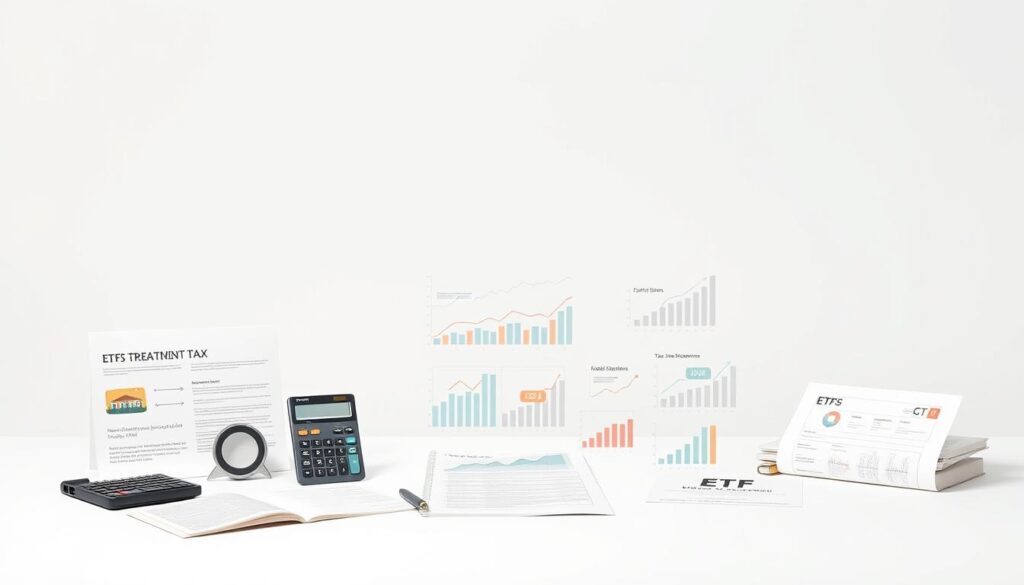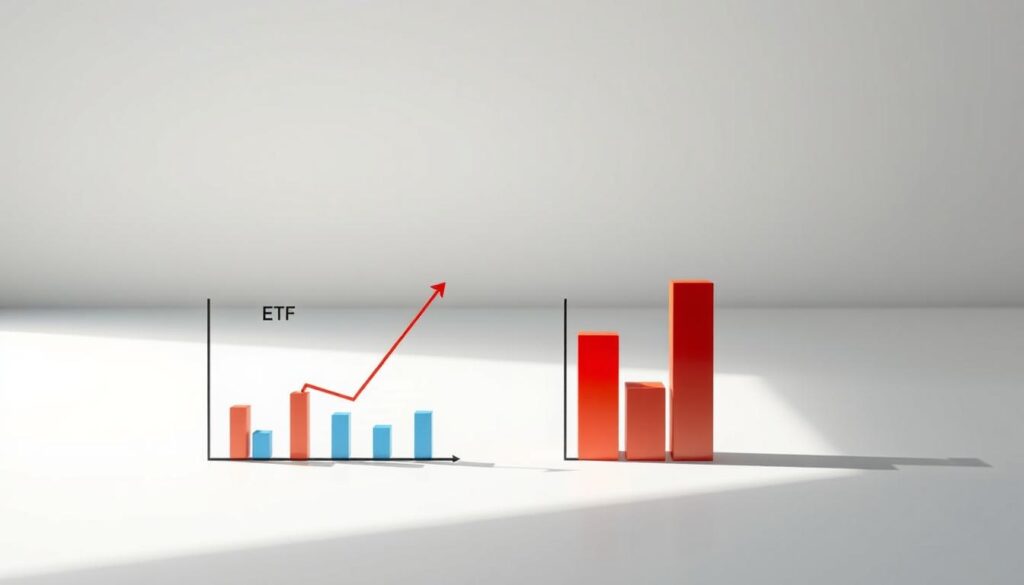Investors often ask: Do ETFs pay capital gains? The answer shapes how you manage taxes and grow wealth. ETFs, like those from Vanguard or iShares, are known for flexibility, but their ETF tax implications matter. While these funds aim to minimize taxes, they can still pass along capital gains from buying or selling holdings. This article breaks down when distributions occur, how they affect your portfolio, and why understanding these rules is key for U.S. investors. Learn if Do ETFs Pay Capital Gains impacts your strategy.
Key Takeaways
- Capital gains from ETFs may trigger taxes, even if shares are held long-term.
- ETF distributions vary based on fund type and market activity.
- Comparing ETFs to mutual funds shows differences in tax efficiency.
- Proactive tax planning helps reduce surprises from capital gains events.
- Knowing an ETF’s history of distributions aids in choosing tax-friendly options.
Understanding ETFs and Capital Gains
Exchange-traded funds (ETFs) have become a staple in modern investing, but their tax rules often confuse new investors. Let’s break down the basics to grasp ETF tax treatment and how capital gains play a role.
What is an ETF?
ETFs are investment vehicles traded on stock exchanges like individual stocks. Unlike mutual funds, they offer flexibility and lower costs. Key features include:
- Track indexes (e.g., S&P 500 ETFs)
- Trade intraday at fluctuating prices
- Generally transparent portfolios
How Do Capital Gains Work?
Capital gains arise when an investment is sold for more than its purchase price. For ETFs, this means:
| Type | Explanation |
|---|---|
| Realized Gains | Profit after selling the ETF |
| Unrealized Gains | Paper gains while holding the ETF |
ETF tax implications depend on whether gains are realized. Holders pay taxes only when profits are locked in, making timing crucial.
Capital Gains Distribution in ETFs
Capital gains distributions from ETFs occur at specific times, impacting investor tax obligations. These events are critical to understand for optimizing tax strategies. Let’s break down the key details.
When Do ETFs Distribute Capital Gains?
Most ETFs issue ETF capital gain distribution annually, typically in late December. This timing aligns with tax year deadlines. Distributions happen when an ETF sells securities at a profit, passing gains to shareholders. Even tax-efficient ETFs like the S&P 500 trackers (e.g., SPY, VOO) may distribute small amounts yearly. These payments are taxable as capital gains income, even if reinvested.
Factors Influencing Capital Gains Distribution
- Portfolio turnover: Frequent trading increases likelihood
- Index changes: Rebalancing triggers asset sales
- Fund size shifts: Large inflows/outflows affect holdings
- ETF structure: Creation/redemption processes reduce but don’t eliminate distributions
High-turnover ETFs like sector-specific funds often distribute more than passive index funds. For example, the popular ARKK innovation ETF historically shows higher distributions due to active management. Investors should check annual reports for ETF distributions taxable details before purchase.
Tax Treatment of ETFs
Understanding the ETF tax treatment helps investors avoid surprises at tax time. Capital gains distributions from ETFs trigger tax consequences of ETFs that must be reported annually. Here’s how it works:
Are ETF Capital Gains Taxable?
Yes. All capital gains distributions from ETFs are taxable in the year they’re paid. Even if you reinvest proceeds automatically, the IRS requires reporting on Form 1099-DIV. Investors receive this form detailing taxable amounts by December 31. Ignoring these distributions could lead to penalties.

Short-Term vs. Long-Term Capital Gains
Holdings determine tax rates. Here’s the breakdown:
- Short-term gains (held ≤1 year): taxed as ordinary income (up to 37%).
- Long-term gains (held >1 year): qualify for preferential rates (0%, 15%, or 20% depending on income).
For example, selling an ETF after 10 months triggers higher taxes than holding it for 13 months. Review your holding periods annually to align with your tax strategy.
Smart investors prioritize ETF tax treatment when choosing accounts. Consider holding tax-inefficient ETFs in IRAs to minimize the tax consequences of ETFs. Always consult Form 1099-DIV details to optimize your portfolio’s after-tax returns.
Avoiding Capital Gains with ETFs
Smart strategies can help investors reduce ETF capital gains taxes and maximize returns. By focusing on ETF tax efficiency, you can keep more money in your portfolio and out of tax forms.
Tax-Efficient Strategies for ETF Investors
Try these steps to lower your tax burden:
- Place tax-inefficient ETFs in retirement accounts like IRAs or 401(k)s.
- Avoid buying ETFs right before their distribution dates to skip capital gains charges.
- Use tax-loss harvesting to offset gains by selling losing positions strategically.
- Consider direct indexing for personalized tax advantages if you have significant assets.
The Role of Index Funds in Minimizing Capital Gains
Index ETFs, like those tracking the S&P 500, often have lower turnover than actively managed funds. Fewer trades mean fewer taxable events. Their creation/redemption process allows in-kind exchanges, avoiding triggering ETF capital gains taxes. While index ETFs may have slightly higher expense ratios, their long-term tax savings often outweigh costs. Always balance tax efficiency with your overall financial goals.
Impact of Capital Gains on ETF Prices
When ETFs distribute capital gains, their net asset value (NAV) adjusts to reflect the payout. This process directly impacts share prices, creating important considerations for investors. Let’s break down how these changes work and what history shows.
NAV Adjustments During Distributions
After an ETF capital gain distribution, a fund’s NAV drops by the distribution amount. For example, if an ETF trades at $100 and pays a $5 capital gain distribution, its NAV resets to $95. This drop doesn’t signal a loss—it’s a tax-related adjustment. Investors holding shares before the ex-dividend date receive the distribution but see their NAV decrease. Understanding this avoids confusion during price fluctuations.
Historical Patterns in Distributions
Data reveals trends in how market conditions shape Do ETFs Pay Capital Gains distributions. Below is a snapshot of how different environments affect distributions:
| Market Phase | Capital Gain Frequency | Example Sectors |
|---|---|---|
| Bull markets | Higher distributions | Technology, energy |
| Market downturns | Lower or deferred | Utilities, bonds |
| Sector rotations | Varies by fund type | Healthcare, commodities |
“Distribution patterns often mirror market cycles, impacting both taxable and tax-advantaged accounts.” – Morningstar ETF Research Report
Long-term investors may see minimal impact, while traders timing entries around distribution dates could avoid unintended tax events. Monitoring historical trends helps align strategies with these shifts.
Comparing ETFs and Mutual Funds
When choosing between ETFs and mutual funds, understanding their tax consequences of ETFs and ETF tax efficiency can shape your investment strategy. Let’s break down how these vehicles handle capital gains and taxes.

Capital Gains Distribution: ETFs vs Mutual Funds
ETFs often distribute fewer capital gains than mutual funds. Why? ETFs use an in-kind creation/redemption process, avoiding taxable sales. Mutual funds, by contrast, must sell holdings to meet redemptions, triggering distributions. Here’s the split:
- ETFs: Minimal distributions due to institutional share swaps
- Mutual Funds: Frequent taxable distributions to all shareholders
Tax Efficiency Between ETFs and Mutual Funds
Data shows ETFs hold a clear edge. A 2023 study comparing 500+ funds found:
| Asset Class | ETF Avg Distribution (%) | Mutual Fund Avg Distribution (%) |
|---|---|---|
| US Stocks | 0.15 | 0.85 |
| Bonds | 0.05 | 0.42 |
| International Stocks | 0.20 | 0.73 |
These figures highlight ETF tax efficiency benefits. However, tax consequences of ETFs may vary in tax-advantaged accounts like IRAs where distributions matter less. Always review fund-specific details before investing.
Tools for Tracking Capital Gains in ETFs
Managing tax obligations starts with tracking when and how ETFs distribute taxable income. Brokerage platforms and specialized tools simplify this process, helping investors stay ahead of ETF distributions taxable and ETF dividends taxable.
Using Brokerage Platforms
Major platforms like Vanguard, Fidelity, and Charles Schwab offer built-in tools. Log into your account to find:
- Distribution calendars showing upcoming dates for taxable events
- Tax reports highlighting ETF dividends taxable and cost basis calculations
- Historical records of past distributions for audit-ready documentation
Capital Gains Calculators and Software
For deeper analysis, third-party tools like TurboTax or Mint integrate with ETF holdings. Free options like IRS tax forms or Excel templates work for simple portfolios. Premium tools offer:
- Automated tracking of ETF distributions taxable across accounts
- Comparisons between short-term and long-term tax outcomes
- Alerts for distribution dates to adjust holdings strategically
Choose tools based on portfolio size. Casual investors might prefer brokerage tools, while complex portfolios benefit from advanced software. Regularly review these resources to align tax planning with investment goals.
Strategies for Selling ETFs
Timing and tactics matter when selling ETFs. These steps help cut ETF capital gains taxes and simplify ETF tax implications:
When to Sell an ETF to Minimize Capital Gains
- Avoid sales during distribution periods to dodge sudden tax hits.
- Hold for over a year to qualify for lower long-term rates on profits.
- Spread sales across years to balance taxable income.
Tax-Loss Harvesting with ETFs
Turn losses into savings by selling ETFs at a loss. Key rules:
- Replace with a non-identical ETF (e.g., switch from SPY to IVV) to avoid wash-sale penalties.
- Use losses to offset up to $3,000 of taxable income yearly.
Example: Selling an S&P 500 ETF at a $2,000 loss could cut tax bills by up to $600 (assuming 30% tax rate). Always track wash-sale rules to stay compliant.
FAQs about ETFs and Capital Gains
Many investors have questions about how ETFs handle capital gains and taxes. Here’s a breakdown of key points to help simplify your research.
Do all ETFs pay capital gains?
No. Do ETFs Pay Capital Gains depends on their structure. Tax-efficient ETFs like broad-market index funds rarely distribute capital gains. Actively managed or niche ETFs, however, may distribute more frequently. Here’s a quick comparison:
| ETF Type | Capital Gains Frequency | Tax Efficiency |
|---|---|---|
| Broad index ETFs | Rare | High |
| Actively managed ETFs | Occasional | Moderate |
| Niche sector ETFs | Common | Low |
How can I find out if an ETF has capital gains distributions?
Research these sources to stay informed:
- Check the ETF provider’s website for annual reports or distribution histories.
- Use platforms like Morningstar or FINRA’s BrokerCheck to review past distributions.
- Review SEC filings, specifically Form N-1A, for official disclosures.
Most ETFs announce distributions in late November or December each year. Compare this info with ETF dividends taxable rates to plan your strategy.
Conclusion: Making Informed Investment Decisions with ETFs
Choosing the right ETFs involves weighing multiple factors, including ETF tax implications and long-term growth potential. By understanding how these funds handle capital gains, investors can align their portfolios with their financial goals more effectively.
Balancing Taxes and Investment Goals
While ETF tax efficiency is a key advantage, it shouldn’t overshadow other priorities like cost, diversification, and risk tolerance. A well-rounded approach considers tax savings without sacrificing core objectives. For instance, low expense ratios paired with tax-smart strategies can amplify returns over time.
Long-Term Benefits of Understanding Capital Gains
Over decades, even minor tax advantages add up. Investors who master these mechanics can reduce liabilities and boost compounding. Staying informed about distributions and reinvestment timing ensures strategies stay ahead of market shifts. Proactive planning turns small savings into meaningful wealth over time.

